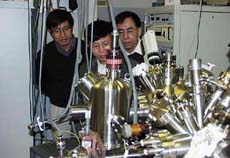|
|

Having fabricated
the world’s smallest single-walled carbon nanotube, researchers
at The Hong Kong University of Science and Technology are discovering
some of its unique properties.
 At 0.4
nanometres (1 million nanometres equal 1 mm), the tube is so small
that it defies the normal behaviour of materials. One exciting discovery,
said Prof Ping Sheng, director of HKUST’s Institute of Nano
Science and Technology, is that the ultrathin nanontubes exhibit
super conducting behaviour. “Here superconductivity refers
to the phenomenon where a material loses all resistance to electricity.
Pure carbon has never been known to possess this property so our
discovery is significant,” said Prof Sheng. At 0.4
nanometres (1 million nanometres equal 1 mm), the tube is so small
that it defies the normal behaviour of materials. One exciting discovery,
said Prof Ping Sheng, director of HKUST’s Institute of Nano
Science and Technology, is that the ultrathin nanontubes exhibit
super conducting behaviour. “Here superconductivity refers
to the phenomenon where a material loses all resistance to electricity.
Pure carbon has never been known to possess this property so our
discovery is significant,” said Prof Sheng.
|
Prof
Sheng (right) and Prof Tang (left) using a scanning-tunnelling
microscope (STM) which can magnify to atom level.
|
 |
 The
carbon nanotubes could also one day be used in fuel cells. As a
storage medium, they have twice the capacity of graphite used in
everyday lithium batteries which power appliances including mobile
phones and PDAs. The
carbon nanotubes could also one day be used in fuel cells. As a
storage medium, they have twice the capacity of graphite used in
everyday lithium batteries which power appliances including mobile
phones and PDAs.
 Whereas
1 gram of graphite can store enough lithium for a release of 374
milliamp hours, its carbon nanotube equivalent can help store more
than 700 mA/hrs. Whereas
1 gram of graphite can store enough lithium for a release of 374
milliamp hours, its carbon nanotube equivalent can help store more
than 700 mA/hrs.
 Researchers
are also looking at the potential of carbon nanotubes for storing
hydrogen for fuel cells. “The impact of hydrogen storage is
great,” said Prof Shing “because hydrogen fuel causes
zero pollution. Its by-product is pure water.” Researchers
are also looking at the potential of carbon nanotubes for storing
hydrogen for fuel cells. “The impact of hydrogen storage is
great,” said Prof Shing “because hydrogen fuel causes
zero pollution. Its by-product is pure water.”
 The
ultra-small nanotubes have optical properties too. As well as good
polarizers of light, they can be photo luminescent with possible
applications in optical communications such as light emitting diodes
(LEDs) and lasers. The
ultra-small nanotubes have optical properties too. As well as good
polarizers of light, they can be photo luminescent with possible
applications in optical communications such as light emitting diodes
(LEDs) and lasers.
 Said
Prof Sheng: “If carbon, the element of life, can have light-emitting
properties, the implications could be wide and very important.” Said
Prof Sheng: “If carbon, the element of life, can have light-emitting
properties, the implications could be wide and very important.”
 He added:
“To me, nanoscience is the most exciting area of science today;
it gives humans a handle on manipulating the basic properties of
matter.” He added:
“To me, nanoscience is the most exciting area of science today;
it gives humans a handle on manipulating the basic properties of
matter.”
Principal
Investigator
Prof Zikang Tang : phzktang@ust.hk

|

